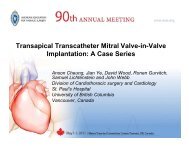Robotic Mitral Valve Surgery "The Chitwood Clamp"
Robotic Mitral Valve Surgery "The Chitwood Clamp"
Robotic Mitral Valve Surgery "The Chitwood Clamp"
Create successful ePaper yourself
Turn your PDF publications into a flip-book with our unique Google optimized e-Paper software.
<strong>Robotic</strong> <strong>Mitral</strong> <strong>Valve</strong> <strong>Surgery</strong>"<strong>The</strong> <strong>Chitwood</strong> Clamp"AATS <strong>Robotic</strong> Cardiac <strong>Surgery</strong>May 1, 2010Evelio Rodriguez, MD; L. Wiley Nifong, MD; andW. Randolph <strong>Chitwood</strong>, Jr., MDEast Carolina Heart InstituteGreenville, NC, USA
• Research Support• ATS Medical• Cardionet Inc.• Glaxo Smith-KlineDisclosures• Speaker• ATS Medical• Intuitive Surgical• Scientific Advisory Board• Cardionet Inc.
Overview1. Set-up options for robotic MV surgery1. Cannulation Techniques2. Review data from 555 cases performedat our institution3. Review literature comparing differentperfusion techniques
Port Placement
1-cm Fourth Arm1.2-cm Camera1-cm Left ArmTransthoracicAortic Clamp1-cm Right Arm
Cardiopulmonary Bypass Options• Arterial Cannulation‣ Femoral (unilateral or bilateral)‣ Aortic‣ Axillary• Venous Drainage‣ Two-staged femoral venous‣ Femoral venous and IJ/SVC drainage‣ PA Vent (Endovent)• Cardioplegia‣ Antegrade‣ Retrograde (via IJ or RA)‣ V-Fib Arrest
Peripheral Perfusion
<strong>Chitwood</strong>-Debakey Aortic Clamp
Advantages and Disadvantages“<strong>Chitwood</strong> Clamp”Endoclamp‣ Simple‣ Less Cost‣ Potential PA and LAAinjury‣ Interference with SVC‣ Interference with<strong>Robotic</strong> Arms‣ Have to Deal withAortic Cardiolegia Site‣ Learning Curve‣ Expensive‣ Peripheral AccessIssues‣ EndoballonObstruction of Lefttrigone Area‣ More Versatile• Redos• Aortic Insuffiency
Cardioplegia
Cardioplegia and Cross Clamp
2D and 3D TEE
<strong>Mitral</strong> <strong>Valve</strong> Repair
<strong>Robotic</strong> <strong>Mitral</strong> Repairs (N=555)77%Leaflet Rsn + Annuloplasty N=124 (22.3%)Leaflet Rsn + Sliding Plasty With/Without Chordal Proc + Annuloplasty N=108 (19.5%)Chordal Procedure (no leaflet resection) + Annuloplasty N=61 (10.9%)Leaflet Rsn + Chordal Procedure + Annuloplasty N=135 (24.3%)(Posterior Leaflet Shortening – “Haircut Procedure” N=71)Annuloplasty alone N=69 (12.4%)“Edge-to-Edge” (Alfieri) + Annuloplasty N=11 (1.9%)Leaflet Repair + Annuloplasty N=37 (6.6%)Other N=11 (2.1%)
HOURSIntraoperative Times (N=555)CPBXC
Complications (N=555)• Operative Deaths N = 1 (0.2%)• In-Hospital Deaths N = 15 (2.7%)• Return for Bleeding N = 15 (2.7%)• Myocardial Infarctions N = 4 (0.7%)• Strokes N = 3 (0.5%)• Infections N = 1 (wound)• Transfused 23.9%• Perfusion Complications N = 2 (0.4%)• Pleural Effusion N = 34 (6.1%)• Re-operations (band dehiscence) N = 6 (1.1%)• Re-operations (other, progression of disease) N = 10 (1.8%)• Re-operations (SAM) N = 2 (0.4%)
JTCVS, 133 (4); 1066-1070, 2007
Modi et al. JTCVS, 137 (6); 1481-1487, 2009
Conclusions• Minimally invasive and robotic assistedMV surgery is safe.• Arterial perfusion related complicationscould be significantly minimized withproper planning.• Surgeons should be familiar and proficientin using all cannulation andcadioplegic/fibrillatory techniques.
Thank You
Scalan Instruments
Conversions to Videoscopic• Device Complications N=3 (0.5%)• Poor Exposure N=4 (0.6%)• External Instrument Conflict N=1 (0.2%)• Changed to Replacement N=1 (0.2%)
Exposure
Exposure of <strong>Mitral</strong> <strong>Valve</strong>
Patient Set-UpMid ClavicularCameraLeft Atrial RetractorLeft PortWorking PortAnterior AxillaryRight PortMid AxillaryPosterior Axillary
















